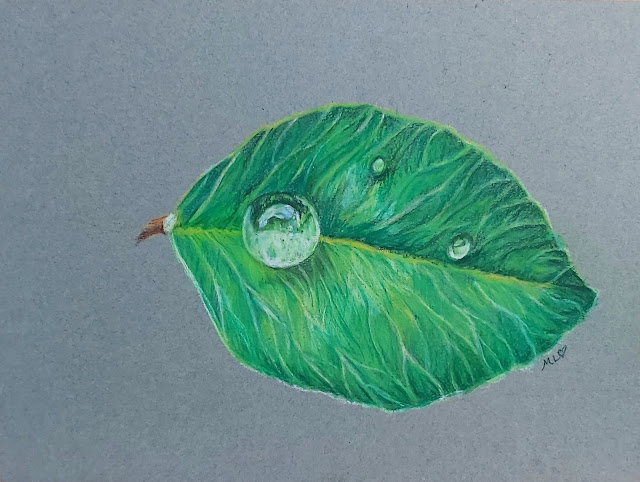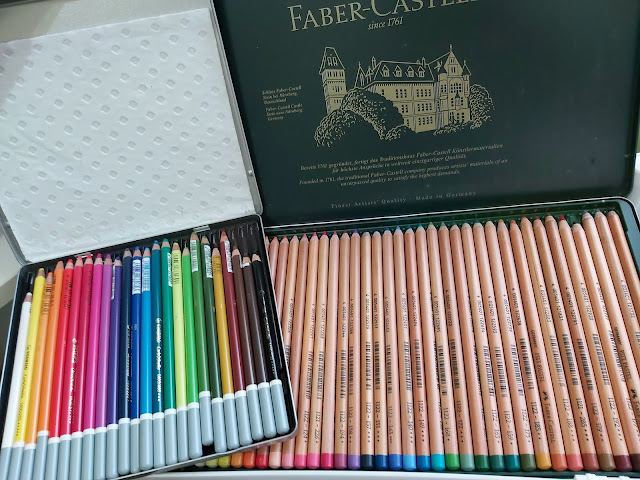The water droplet challenge - in coloured pencils and oil pastels
In my last post, I talked about how I enjoyed my Prismacolor Art Stix tremendously. I had so much fun with them that I decided to draw another piece using the Art Stix right away. I decided to attempt something I usually don't like drawing - nature. I was fascinated by water droplets and wanted to see if I could replicate them, so I chose a photo reference of a water droplet on a leaf. This was the final piece:
I was quite pleased with it, mostly because I don't typically have a lot of success drawing leaves. I'm showing some progress photos here.
This was a very limited colour palette.
Buoyed by the results of this drawing, I rashly decided I was going to draw a whole series of pieces featuring water droplets on various things. Overly ambitious projects usually have a habit of bombing for me and unfortunately, the next drawing of water droplets on a maple leaf, again using Art Stix, turned out less than satisfactory (hence am not showing it here).
A little miffed, I thought, maybe I should try a different medium. How about oil pastels? I picked a pretty photo reference of a blue rose drenched in dew.
 |
| Photo: Pixabay |
In painting, some are just fraught with difficulty from the start, while others seemingly sail through. This drawing was one of the latter. I loved drawing it. The colours practically popped off the paper and the rose came to life bit by bit.
I used a range of blues and whites from my Mungyo Gallery Soft Artists Oil Pastels (which I reviewed here and absolutely love) and Sakura Cray-Pas Expressionist Oil Pastels (this is a new set which I will review soon), as well as three Faber-Castell Albrect Durer coloured pencils. Coloured pencils do work on top of oil pastels and are useful in drawing details that the fat oil pastel sticks can't achieve.
The final drawing, which I ♥ to bits.
So pleased with the result I was, that I decided to up the ante. I would draw the next water droplet picture in soft pastels so I could have a range of different mediums! I had intended to draw an apple with dew. To cut a long story short, that one bombed badly. In fact, I was pretty discouraged by it because I just couldn't get the texture of the apple to look right and the blending was a downright mess.
It took a lot of effort to talk myself into trying another piece, I was so done with this water droplet challenge. But in the end, I decided I would give it one last try, and reverted once again to oil pastels. This time, I wanted to go for a more artistic picture and I thought this looked interesting.
 |
| Photo: Pixabay |
First, I coloured in the background with a light wash and blended it out. Looks like some kiddy art! I was really nervous at this stage.
Then when I started painting the background, it began to morph. I didn't really intend to have those distinct strips of colour, but somehow when I drew in the circles, they kinda turned out that way. By this time, I realised it was too late to change course even if I wanted to.
When I drew in the flower stems, it started to look like some Japanese style painting. Again, not deliberate.
Finally, I added in the flower petals and water droplets. Not even sure they look like water droplets! The effect is completely different from the photo reference, but I guess you can say it's...well, interesting.
This challenge was an interesting one for me, not least because it was a roller coaster ride. Out of the five pieces I did, two worked out great, two didn't work out at all, and one turned out completely different than expected. I know that I can't expect masterpieces each time, and I should focus on the process instead of the outcome. Yet when a drawing turns out badly, I still feel discouraged and daunted, especially when I don't know what I did wrong. This instils fear because I feel that I would make the same mistake the next time, since I don't know how to fix it.
Yet, I know that art is about growth, and growth only comes from learning and making mistakes. I learned a long time ago in my 30 years as a writer that the only way to be a better writer is to keep writing. And so, applying the same principle, I will keep painting. Hopefully in time, I will look back and see that it was all worthwhile.














Comments
Post a Comment